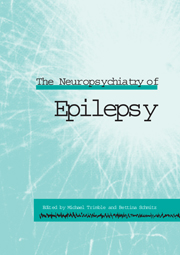Book contents
- Frontmatter
- Contents
- List of contributors
- Part I Background
- Part II Clinical aspects
- Part III Cognitive aspects
- Part IV Nonepileptic attacks
- 13 Epilepsy, dissociation and nonepileptic seizures
- 14 Psychobiology of psychogenic pseudoseizures
- 15 Epilepsy and panic disorder
- Part V Treatment complications
- Part VI Treatment
- Index
14 - Psychobiology of psychogenic pseudoseizures
Published online by Cambridge University Press: 05 October 2010
- Frontmatter
- Contents
- List of contributors
- Part I Background
- Part II Clinical aspects
- Part III Cognitive aspects
- Part IV Nonepileptic attacks
- 13 Epilepsy, dissociation and nonepileptic seizures
- 14 Psychobiology of psychogenic pseudoseizures
- 15 Epilepsy and panic disorder
- Part V Treatment complications
- Part VI Treatment
- Index
Summary
Introduction
Psychogenic pseudoseizures are paroxysmal events which mimic epileptic seizures. While patients suffering from these symptoms are referred to neurologists because they are mistakenly believed to have epilepsy, neurologists consider the underlying disorder to be of psychological aetiology. Our observations on the nature of pseudoseizures are based on a carefully studied sample of 100 patients with pseudoseizures evaluated over a period of 5 years at the University of Michigan Medical Center. The patients were evaluated by intensive neurological, clinical psychological and/or neuropsychological investigations. Psychodynamic psychotherapy was performed in a portion of this group. The results of these efforts have provided us with insights into the psychopathology of the disorder (Kalogjera-Sackellares, 1995; Kalogjera-Sackellares and Sackellares, 1997a, b, 1999). In addition, we discovered evidence to suggest that neurological disturbances may play a role in the pathophysiology of the disorder (Kalogjera-Sackellares and Sackellares, 1999). A recurrent theme among our patients was trauma. This included physical as well as emotional trauma (Kalogjera-Sackellares, 1995; Kalogjera-Sackellares and Sackellares, 1999). The prevalence of trauma, as well as the post-traumatic character of many of the symptoms, do not fit with the current diagnostic framework of the somatoform disorders (Guggenheim and Smith, 1995) under which pseudoseizures are typically considered. The concept of somatoform disorders obscures the operative impact of both the emotional as well as physical trauma which are cornerstones of our approach to this disorder.
- Type
- Chapter
- Information
- The Neuropsychiatry of Epilepsy , pp. 210 - 225Publisher: Cambridge University PressPrint publication year: 2002



